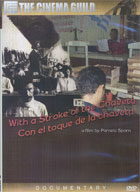
With the Stroke of the Chaveta (Con el toque del la chaveta) 2008
Distributed by Cinema Guild, 115 West 30th Street, Suite 800, New York, NY 10001; 212-685-6242
Produced by Pamela Sporn
Directed by Pamela Sporn
DVD, color, 28 min.
Sr. High - Adult
Latin American Studies, Labor Relations
Date Entered: 04/08/2009
Reviewed by Brian Falato, University of South Florida Tampa Campus LibraryThe hand-rolling of cigars on a mass scale is still practiced in Cuba and the custom of reading to the cigar makers as they work is also still done. Workers will hear articles read from newspapers and magazines, plus nonfiction books and novels, both classic and contemporary. If the workers like the performance of the lector (Spanish for reader), they will applaud by banging the handles of their chavetas (the knives used for cutting tobacco) on their work desks. And they will express their disapproval by yelling and even throwing down their chavetas.
When most cigar makers in Cuba were illiterate, the readings served as an informal education. They also became a consciousness-raising tool in the movement for independence from Spain. (The colonial governor for Cuba even banned cigar factory readings for a time because it was thought to be disruptive to the social order, but workers succeeded in getting the lectors returned to the factories.) The 10 Year War that started in 1868 was the first Cuban bid for independence, and the turmoil wrought by it meant that many cigar factories and workers left Cuba for the United States, primarily settling in Florida and New York. They brought the tradition of the lector with them, and readings in U.S. factories continued until the 1930s, when hand-rolled cigars began to be replaced by machine-made products.
Some Americans may have first become aware of the cigar factory lector through the Pulitzer Prize-winning play Anna in the Tropics by Nilo Cruz. But Cruz took some liberties with the facts when it came to the lector, so this documentary serves as a way to get the real story. Made by a student at Hunter College in New York as part of the requirements for an MFA in integrated media arts, it was shot in Cuba and the narration and all interviews are in Spanish. We learn that the lector is chosen by the workers and that they vote on the material the lector will read. Gabriel Garcia Marquez and Ernest Hemingway are popular choices among novelists, and Victor Hugo’s Les Miserables has been read three times in one factory. One Hundred Hours with Fidel, a book of interviews with Castro, is also mentioned.
At 28 minutes, the video obviously can’t give an in-depth look at Cuban cigar factories or the lector, and U.S. factories are included only through the historical newspaper clippings that are shown. But the video does serve as an introduction, and is recommended on that basis.